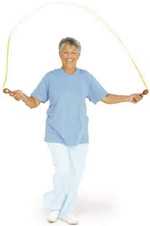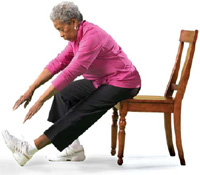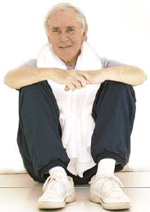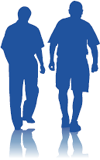If you’ve been exercising regularly, you’ll soon be able to tell when it’s time to move ahead in your activities. For example, when you can lift a weight easily more than 10 times, it’s time to add more weight in your strength exercises. And when your endurance activity no longer feels challenging, it’s time to exercise a little longer, or make it a little more difficult, such as by walking up steeper hills.
 The simple tests shown in this chapter will show you just how far you’ve come. You might want to test yourself every month or so. Write down your scores each time so you can see your improvement the next time you test yourself.
The simple tests shown in this chapter will show you just how far you’ve come. You might want to test yourself every month or so. Write down your scores each time so you can see your improvement the next time you test yourself.
You might want to do these tests for a couple of reasons. For one, most people make rapid progress soon after they start to exercise, and it’s encouraging to see your scores improve after just a month. For another, these tests are a good way to let you know if you are continuing to progress and you need to update your goals. For example, you may want to walk farther or lift heavier weights. But remember, it is normal for your improvement to slow down at times. You can record your scores on the Monthly Progress Test in Chapter 7.
Also remember that each person is different. Some will be able to progress with time; for others, reaching a certain level of activity and staying there is right for their age and ability level.
If you’re not ready to do these tests, don’t worry, just keep working on your current exercises and activities until you are. Whether you are testing yourself or actually exercising, your pace should never make you feel dizzy, light-headed, or sick to your stomach, and you shouldn’t feel pain.
And one last tip: Whether or not you do these tests, don’t forget to congratulate yourself for your efforts. Tell your family and friends about your achievements. You’ve made a lot of progress, and you’re ready for more!
Test Yourself
 Endurance. Pick a fixed course — the distance from your house to the corner, once around the track at your local high school, or from one end of the mall to the other — whatever is convenient. See how long it takes to walk that distance. Do this test every month or so. As your endurance improves, it should take less time.
Endurance. Pick a fixed course — the distance from your house to the corner, once around the track at your local high school, or from one end of the mall to the other — whatever is convenient. See how long it takes to walk that distance. Do this test every month or so. As your endurance improves, it should take less time.
Upper-body Strength. Count the number of arm curls (see Chapter 7 strength exercises) you can safely do in 2 minutes. If you are just starting to exercise, you may have to stop and rest before the 2 minutes are up. That’s okay; it still gives you a great starting point to measure your progress. Repeat the test 1 month later. The number of arm curls you can do should increase.
Lower-body Strength. Count the number of chair stands (see Chapter 7 strength exercises) you can safely do in 2 minutes. You may have to stop and rest before the 2 minutes are up if you are just starting to exercise. That’s okay; you will be able to measure your progress from this starting point. Repeat the test 1 month later. The number of chair stands you can do should increase.
Balance. Time yourself as you stand on one foot, without support, for as long as possible. Stand near something sturdy to hold on to, in case you lose your balance. Record your score. Repeat the test while standing on the other foot. Test yourself again in 1 month. The amount of time you can stand on one foot should increase.
Flexibility. If you’ve had hip or back surgery, talk with your doctor before you do this test. Sit securely toward the front of a sturdy chair, and stretch one leg straight out in front of you with your heel on the floor, toes pointing upward. Bend the other leg so that your foot is flat on the floor. With your elbows slightly bent and your hands palms down, slowly bend forward from your hips (not your waist) and reach as far as you can toward your toes. How far down can you reach until you feel a stretch? Test yourself again in 1 month. Eventually, you should be able to reach closer to your toes.
 Other Ways to Measure Progress
Other Ways to Measure Progress
As you become more active, you’ll probably notice other signs that you’re getting more fit:
- You have more energy.
- Your overall mood and outlook on life have improved.
- It’s easier to do your usual daily activities.
- Climbing a couple of flights of stairs is easier.
- It’s easier to get in and out of the car.
- You can get down on the floor and play a game with your grandchildren, and get back up again more easily when the game is over.
- You’re sleeping better at night.
- You have less pain when you move around.
- Symptoms of an ongoing health condition may improve.
 Marty’s “exercise buddies” keep him going:
Marty’s “exercise buddies” keep him going:
“Every morning I head out to the mall — not to shop, but to join my mall-walkers group. At 75, I’m one of the youngest members. When I retired, my wife Harriet insisted that we walk every morning. Some of us move at a steady clip through the mall, while others take a slower pace. We count our laps and keep a daily record of our progress — pushing ourselves to go a little faster, a little farther.
When Harriet died unexpectedly, it was quite a blow, but the walkers were my lifeline. They kept me moving when all I wanted to do was sit. At first, I walked because it was something to do each morning. But now, I realize that I like how it feels to be moving. Measuring how fast I can walk gives me goals, something to work toward. I walk and feel stronger every day. I often think of Harriet and silently thank her for insisting that we walk together.”
<< Back | Next >>
